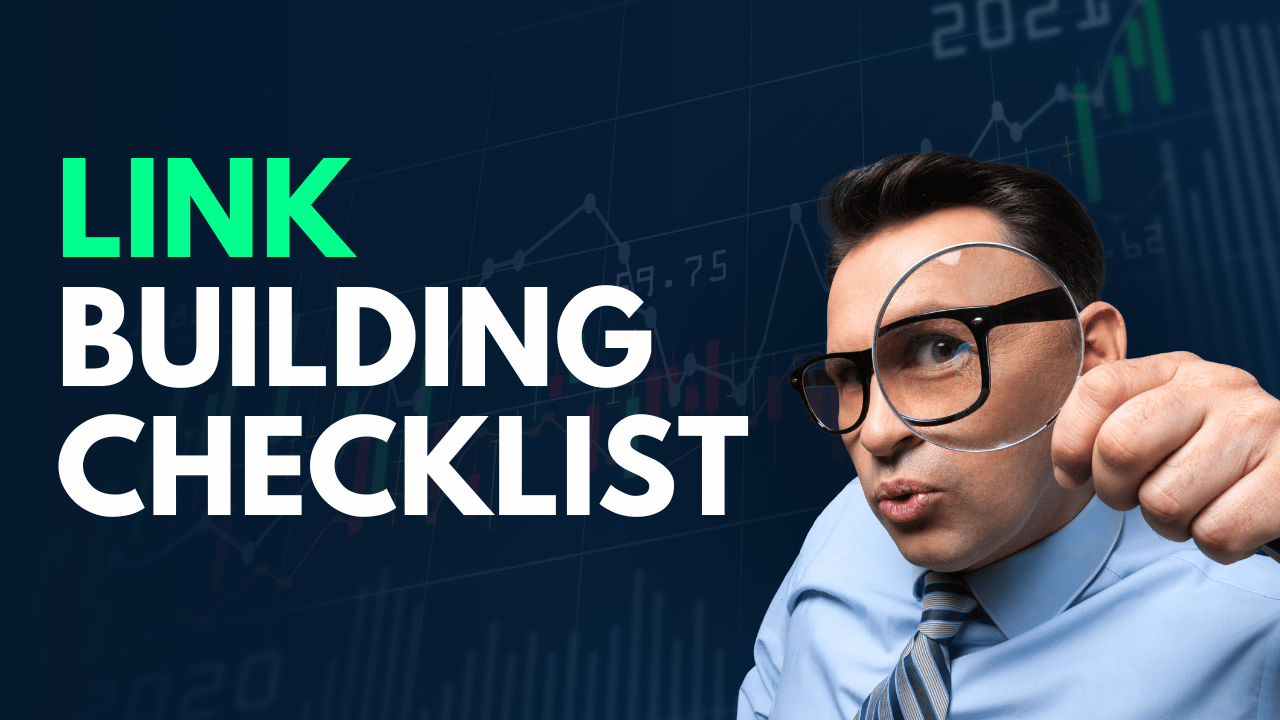SEO
A Link Building Checklist to Earn More & Better Links
A Link Building Checklist to Earn More & Better Links
Link building plays a crucial role in the world of search engine optimization (SEO). By acquiring high-quality and relevant links from authoritative websites, you can improve your website’s visibility, organic rankings, and ultimately drive more targeted traffic. However, link building can be a complex and time-consuming process if not approached strategically. In this article, we will explore a comprehensive link building checklist that can help you earn more and better links, ensuring maximum impact for your SEO efforts.
1. Introduction to link building and its importance
In today’s competitive digital landscape, search engines rely on links as a crucial ranking factor. Links act as votes of confidence from one website to another, signaling to search engines that the linked website is trustworthy, valuable, and deserving of higher rankings. Therefore, a well-executed link building strategy becomes essential for any website looking to improve its organic visibility and attract more targeted traffic.
2. Understanding the role of links in SEO
2.1 The impact of links on search engine rankings
Search engines consider links as a vote of confidence and authority. Websites with a strong and diverse backlink profile tend to rank higher in search engine results pages (SERPs) compared to those with fewer or lower-quality links. Link building, when done right, can significantly improve your website’s chances of ranking well for relevant keywords and phrases.
2.2 Different types of links
There are several types of links you can acquire to improve your website’s SEO:
- Editorial links: These are natural links earned through the creation of valuable content that others find worthy of linking to.
- Guest blogging links: By contributing guest posts to relevant websites, you can acquire links back to your own website within the author bio or content.
- Resource links: Links acquired by providing valuable resources or tools that other websites find helpful and link to as references.
- Social media links: Links acquired through social media platforms when users share and engage with your content.
- Directory links: Links from relevant and trustworthy directories within your industry or niche.
- Contextual links: Links within the body of a content piece that are relevant and provide additional value to the reader.
3. The benefits of a link building checklist
A link building checklist provides a systematic approach to your link building efforts, ensuring you cover all essential aspects and maximize your chances of success. Here are some key benefits of using a link building checklist:
3.1 Ensuring a systematic approach to link building
A checklist helps you stay organized and ensures that you don’t miss any crucial steps in your link building campaign. It provides a clear roadmap, making the entire process more manageable and efficient.
3.2 Improving efficiency and effectiveness
By following a checklist, you can streamline your link building efforts and eliminate unnecessary or unproductive activities. This allows you to focus on tactics that yield the best results, maximizing your chances of earning high-quality links.
4. Creating a link building strategy
Before diving into the link building process, it’s crucial to develop a solid strategy. Here are some key steps to consider:
4.1 Defining goals and objectives
Clearly define your link building goals and align them with your overall SEO and business objectives. For example, your goals might include improving organic rankings, increasing referral traffic, or establishing thought leadership within your industry.
4.2 Identifying target audiences and relevant websites
Identify your target audience and the websites they frequent. This will help you tailor your link building efforts to reach the right people and acquire links from authoritative and relevant websites.
4.3 Researching competitor backlinks
Analyze the backlink profiles of your competitors to identify potential link opportunities. Look for websites that are linking to multiple competitors but not to your own site. These are potential targets for outreach and relationship building.
4.4 Developing link-worthy content
Create valuable, informative, and engaging content that naturally attracts links. Focus on creating content that fills gaps in the industry, provides unique insights, or offers practical solutions to common problems. High-quality content is more likely to earn links naturally.
5. Essential elements of a link building checklist
A comprehensive link building checklist should include the following elements:
5.1 Conducting a website audit
Start by evaluating your website’s current link profile. Identify any toxic or spammy links that may be harming your SEO efforts. Remove or disavow these links to ensure they don’t negatively impact your website’s rankings.
5.2 Identifying link opportunities
Use various tools and techniques to find relevant websites and pages where you can potentially acquire links. This may include analyzing competitor backlinks, searching for broken links, or leveraging existing relationships within your industry.
5.3 Outreach and relationship building
Craft personalized outreach emails to website owners or editors, explaining the value of your content and why they should consider linking to it. Building genuine relationships with website owners and influencers in your industry can significantly improve your chances of earning quality links.
5.4 Tracking and monitoring progress
Regularly monitor the progress of your link building campaign. Use tools to track acquired links, monitor changes in your website’s backlink profile, and analyze the impact of link building on your organic rankings and traffic. Adjust your strategy based on the insights gained.
6. Implementing effective link building techniques
There are various link building techniques you can implement to acquire more and better links. Here are a few examples:
6.1 Guest blogging and contributorship
Identify authoritative websites and blogs within your industry that accept guest posts. Contribute high-quality content that provides value to their audience and includes relevant links back to your own website.
6.2 Broken link building
Search for broken links on relevant websites and reach out to the site owners, suggesting your content as a replacement for the broken link. This technique offers a win-win situation as you help them fix broken links while acquiring a valuable link for your website.
6.3 Resource link building
Create comprehensive resource pages or tools within your niche. Reach out to relevant websites, informing them about the resources you’ve created, and suggesting they link to it if they find it useful.
6.4 Content promotion and distribution
Ensure your valuable content reaches your target audience by promoting it through various channels. Share it on social media, engage with industry influencers, and leverage your existing network to amplify its reach. The more visibility your content receives, the higher the chances of earning quality links.
6.5 Social media engagement
Actively engage with your target audience on social media platforms. Participate in relevant conversations, share industry insights, and contribute valuable content. By building a strong social presence, you increase the likelihood of others sharing and linking to your content.
7. Measuring the success of link building efforts
To assess the effectiveness of your link building campaign, it’s important to measure its impact. Here are some key metrics to track:
7.1 Key performance indicators (KPIs)
Identify relevant KPIs that align with your link building goals. This may include organic rankings for target keywords, referral traffic from acquired links, or the number of high-quality links acquired within a specific timeframe.
7.2 Analyzing referral traffic and conversions
Monitor the traffic coming from acquired links and assess its quality. Analyze the behavior of visitors referred from these links, such as time spent on site, pages visited, and conversion rates. This data can help you identify the most effective link sources.
7.3 Monitoring backlink quality and quantity
Regularly analyze your website’s backlink profile to ensure the quality and diversity of acquired links. Use tools to check for spammy or low-quality links and take necessary actions to maintain a healthy backlink profile.
8. Common mistakes to avoid in link building
While implementing your link building strategy, it’s crucial to avoid common pitfalls. Here are some mistakes to watch out for:
8.1 Spammy and low-quality link acquisition
Avoid acquiring links from spammy or low-quality websites. Such links can harm your website’s reputation and have a negative impact on your SEO efforts. Focus on quality rather than quantity when acquiring links.
8.2 Ignoring relevance and context
Ensure the links you acquire are relevant to your website’s niche or industry. Irrelevant links may not provide significant SEO value and can appear suspicious to search engines.
8.3 Neglecting relationship building
Building genuine relationships with website owners, influencers, and industry peers is crucial for successful link building. Avoid focusing solely on link acquisition and prioritize long-term relationship building.
8.4 Overlooking anchor text diversity
Use a diverse range of anchor texts when acquiring links. Over-optimizing anchor texts with exact-match keywords can appear unnatural and may trigger search engine penalties.
9. Conclusion
A well-executed link building strategy can significantly enhance your website’s SEO performance and organic rankings. By following a comprehensive link building checklist, you can ensure a systematic and effective approach to acquiring more and better links. Remember to focus on quality, relevance, and relationship building throughout the process. Regularly measure your link building efforts and make necessary adjustments to optimize results.
FAQs
10.1 What is the best way to start building links?
The best way to start building links is by conducting thorough research and identifying relevant websites within your industry or niche. Reach out to them with personalized and valuable content proposals, showcasing how your content can provide value to their audience.
10.2 How long does it take to see results from link building?
The time it takes to see results from link building can vary depending on various factors, including the competitiveness of your industry, the quality of your content, and the effectiveness of your outreach efforts. Generally, it takes several weeks to months to observe noticeable improvements in organic rankings and traffic.
10.3 Can I buy links to improve my website’s rankings?
Buying links is against search engine guidelines and can lead to severe penalties. It’s essential to focus on earning organic and high-quality links through valuable content creation, outreach, and relationship building.
10.4 Are all links equally valuable for SEO?
No, not all links are equally valuable for SEO. High-quality links from authoritative and relevant websites have a more significant impact on your website’s rankings compared to low-quality or irrelevant links.
10.5 Should I focus on quantity or quality when building links?
Quality should always take precedence over quantity when building links. Acquiring a few high-quality and relevant links can have a more significant impact on your website’s SEO performance than acquiring a large number of low-quality links.

